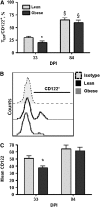Diet-induced obesity in mice reduces the maintenance of influenza-specific CD8+ memory T cells
- PMID: 20592105
- PMCID: PMC2924599
- DOI: 10.3945/jn.110.123653
Diet-induced obesity in mice reduces the maintenance of influenza-specific CD8+ memory T cells
Abstract
Obesity has been associated with increasing the risk for type 2 diabetes and heart disease, but its influence on the immune response to viral infection is understudied. Memory T cells generated during a primary influenza infection are important for protection against subsequent influenza exposures. Previously, we have demonstrated that diet-induced obese (DIO) mice have increased morbidity and mortality following secondary influenza infection compared with lean mice. To determine whether the problem resided in a failure to maintain functional, influenza-specific CD8(+) memory T cells, male DIO and lean mice were infected with influenza X-31. At 84 d postinfection, DIO mice had a 10% reduction in memory T cell numbers. This reduction may have resulted from significantly reduced memory T cell expression of interleukin 2 receptor beta (IL-2R beta, CD122), but not IL-7 receptor alpha (CD127), which are both required for memory cell maintenance. Peripheral leptin resistance in the DIO mice may be a contributing factor to the impairment. Indeed, leptin receptor mRNA expression was significantly reduced in the lungs of obese mice, whereas suppressor of cytokine signaling (Socs)1 and Socs3 mRNA expression were increased. It is imperative to understand how the obese state alters memory T cells, because impairment in maintenance of functional memory responses has important implications for vaccine efficacy in an obese population.
Conflict of interest statement
Author disclosures: E. A. Karlsson, P. A. Sheridan, and M. A. Beck, no conflicts of interest.
Figures



Similar articles
-
Diet-induced obesity impairs the T cell memory response to influenza virus infection.J Immunol. 2010 Mar 15;184(6):3127-33. doi: 10.4049/jimmunol.0903220. Epub 2010 Feb 19. J Immunol. 2010. PMID: 20173021
-
Diet-induced obese mice have increased mortality and altered immune responses when infected with influenza virus.J Nutr. 2007 May;137(5):1236-43. doi: 10.1093/jn/137.5.1236. J Nutr. 2007. PMID: 17449587
-
SOCS4 is dispensable for an efficient recall response to influenza despite being required for primary immunity.Immunol Cell Biol. 2015 Nov;93(10):909-13. doi: 10.1038/icb.2015.55. Epub 2015 Jun 16. Immunol Cell Biol. 2015. PMID: 26077508
-
Selective impairment in dendritic cell function and altered antigen-specific CD8+ T-cell responses in diet-induced obese mice infected with influenza virus.Immunology. 2009 Feb;126(2):268-79. doi: 10.1111/j.1365-2567.2008.02895.x. Epub 2008 Aug 27. Immunology. 2009. PMID: 18754811 Free PMC article.
-
Metabolic and functional impairment of CD8+ T cells from the lungs of influenza-infected obese mice.J Leukoc Biol. 2022 Jan;111(1):147-159. doi: 10.1002/JLB.4A0120-075RR. Epub 2021 Apr 13. J Leukoc Biol. 2022. PMID: 33847405 Free PMC article.
Cited by
-
Increasing HbA1c is associated with reduced CD8+ T cell functionality in response to influenza virus in a TCR-dependent manner in individuals with diabetes mellitus.Cell Mol Life Sci. 2024 Jan 12;81(1):35. doi: 10.1007/s00018-023-05010-4. Cell Mol Life Sci. 2024. PMID: 38214784 Free PMC article.
-
Reduced SARS-CoV-2 mRNA vaccine immunogenicity and protection in mice with diet-induced obesity and insulin resistance.bioRxiv [Preprint]. 2022 Dec 7:2022.12.07.519460. doi: 10.1101/2022.12.07.519460. bioRxiv. 2022. Update in: J Allergy Clin Immunol. 2023 Nov;152(5):1107-1120.e6. doi: 10.1016/j.jaci.2023.06.031. PMID: 36523401 Free PMC article. Updated. Preprint.
-
Emergence of Leptin in Infection and Immunity: Scope and Challenges in Vaccines Formulation.Front Cell Infect Microbiol. 2018 May 9;8:147. doi: 10.3389/fcimb.2018.00147. eCollection 2018. Front Cell Infect Microbiol. 2018. PMID: 29868503 Free PMC article. Review.
-
Obesity in COVID-19 era, implications for mechanisms, comorbidities, and prognosis: a review and meta-analysis.Int J Obes (Lond). 2021 May;45(5):998-1016. doi: 10.1038/s41366-021-00776-8. Epub 2021 Feb 26. Int J Obes (Lond). 2021. PMID: 33637951 Free PMC article. Review.
-
The weight of obesity on the human immune response to vaccination.Vaccine. 2015 Aug 26;33(36):4422-9. doi: 10.1016/j.vaccine.2015.06.101. Epub 2015 Jul 8. Vaccine. 2015. PMID: 26163925 Free PMC article. Review.
References
-
- Bellisari A. Evolutionary origins of obesity. Obes Rev. 2008;9:165–80 - PubMed
-
- Jeffery RW, Harnack LJ. Evidence implicating eating as a primary driver for the obesity epidemic. Diabetes. 2007;56:2673–6 - PubMed
-
- Pi-Sunyer FX. The Obesity epidemic: pathophysiology and consequences of obesity. Obes Res. 2002;10:S97–104 - PubMed
-
- Pi-Sunyer FX. The medical risks of obesity. Obes Surg. 2002;12Suppl 1:6S–11S - PubMed
-
- Fantuzzi G. Adipose tissue, adipokines, and inflammation. J Allergy Clin Immunol. 2005;115:911–9 - PubMed
Publication types
MeSH terms
Substances
Grants and funding
LinkOut - more resources
Full Text Sources
Medical
Research Materials

